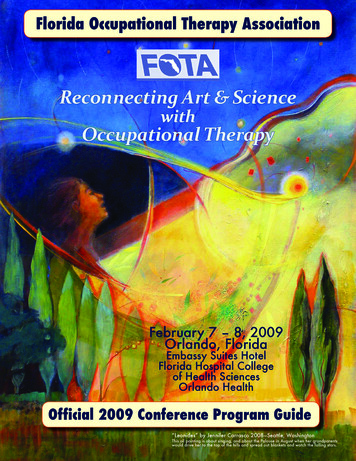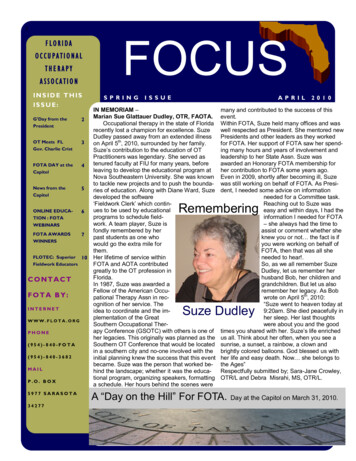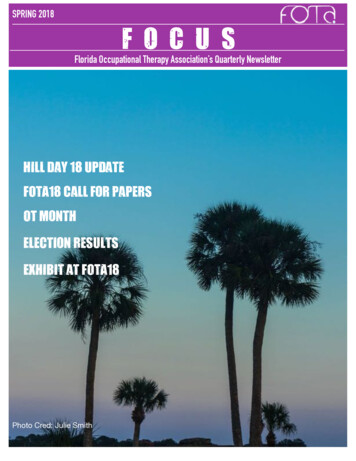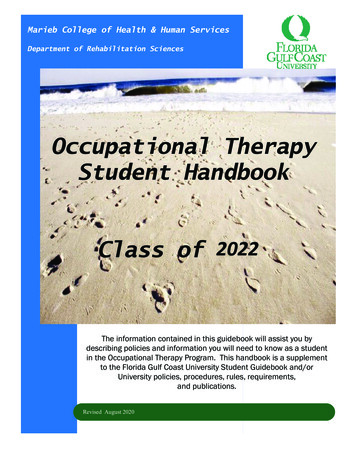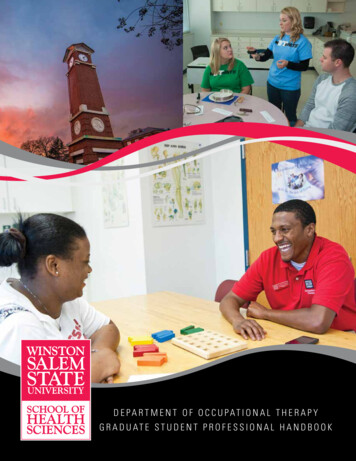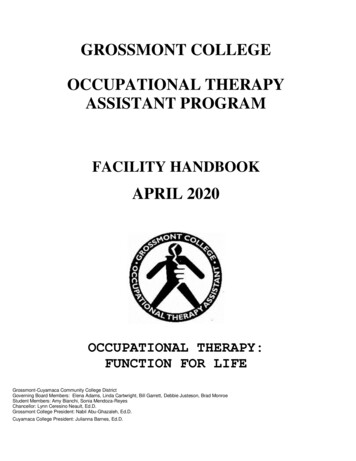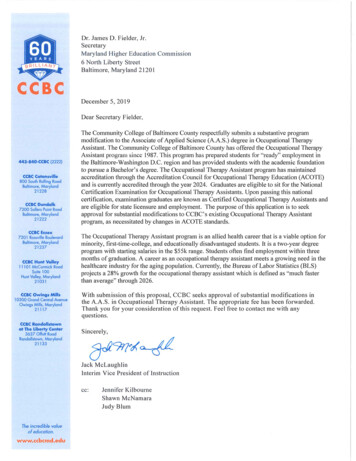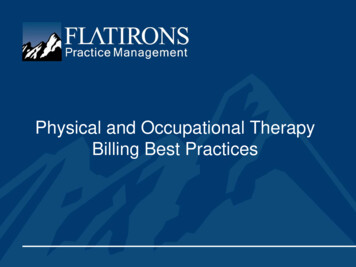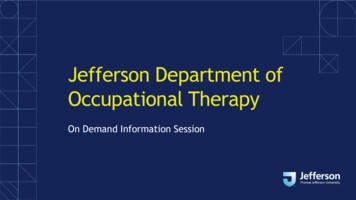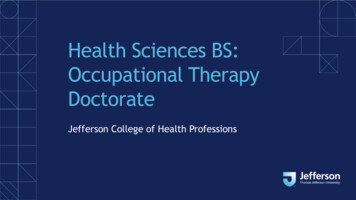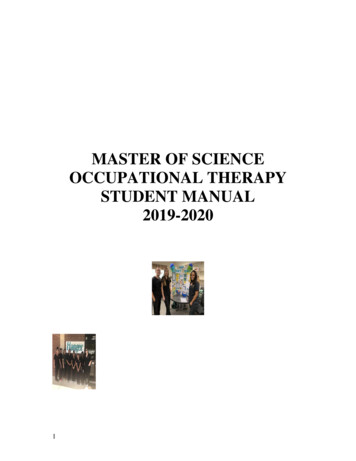
Transcription
MASTER OF SCIENCEOCCUPATIONAL THERAPYSTUDENT MANUAL2019-20201
This student manual is your guide to the policies and procedures that provide theorganizing framework for how things are done in this program and for what expectationsthe faculty has of you. The student handbook serves as a contract between you and thefaculty and program. Once you have read and understand it, please sign theacknowledgement on the final page and give this to Ms. Lewesa Peterson.All students are responsible for understanding and adhering to the contents of thismanual. You are also responsible for meeting registration requirements, deadline dates,and other academic and University requirements for your degree in a timely fashion.Questions about the contents of this manual should be addressed to your advisor or to theDirector of the Division. Your responsibility is to take initiative, to be clear in yourcommunication, to seek out, follow-up and follow-through, and to accept that whetheryou ultimately succeed in reaching your goals is up to you.About the ProfessionOccupational therapy is a health profession that promotes life-long health and well-beingof individuals, groups and communities through engagement in occupation. The primaryobjective embodied within the concept of “occupation” is the practitioner’s use ofactivities meaningful to the client within their own particular environment. Hence,occupational therapy services are provided within the contexts of activities of dailyliving, education, work, play, leisure and social participation. Practitioners provideservices to individuals to increase their daily function, enhance/support health anddevelopment and prevent disability through promotion of effective performance skillswithin environments and using tasks adapted to meet their individualized abilities andneeds.Practitioners work with persons of all ages and cultural backgrounds whose independencehas been impacted by physical and/or mental injury or illness, developmental or learningdisabilities, or adverse environmental conditions. Occupational therapy services areprovided in a variety of settings including general and psychiatric hospitals, rehabilitationcenters, intermediate care facilities, nursing homes, individual’s homes, school systems,community centers and agencies, and private practice. Occupational therapists functionas clinicians, educators, consultants, researchers and administrators. Services toindividuals, families and communities include: evaluation and treatment planning andimplementation; assessment of home, work and community environments; training in theuse of adaptive equipment; community needs assessment and program planning; andreferral to appropriate follow-up services.History of OT at FAMUThe Division of Occupational Therapy, one of the five Divisions within the School ofAllied Health Sciences, was established in 1989. The State of Florida, in its’ 1988-1993strategic plan, identified as one of its critical problems in the rapidly growing State of2
Florida the need for an increased number of allied health practitioners. The Division,consistent with the mission of the University and the State of Florida, has conferred morethan 200 baccalaureate degrees in occupational therapy. The last class of undergraduatestudents received their baccalaureate degrees in 2006. The Division has now transitionedto an entry-level master’s degree program from which the first student graduated in 2007.Philosophy of the DivisionWe believe that humans are complex and active beings whose development is dependentupon participation in occupations. This participation is context dependent and involvesthe whole person. Humans continually adapt as they grow. When this adaptation processis interrupted, occupational therapy utilizes occupation to facilitate change and renewal.The Division of Occupational Therapy believes that occupational therapy is clientcentered and occupation based. It is the role of the occupational therapy educators topromote the use of occupation to assist strength, fitness and wellbeing, growth, change,and adaptation to encourage full participation in meaningful occupation that culminatesin general safety, security and appropriate quality of life. Occupational therapy is sciencedriven and based upon evidence. Occupations will be utilized to prevent, habilitate, andrehabilitate, through the intervention planning process to allow maximum participation inoccupations.We believe students should develop a solid base of knowledge that facilitates criticalthinking, clinical reasoning and problem-solving skills, all of which are essential totransition from student to competent occupational therapy practitioner. Recognizing thatall interventions must be focused on client priorities, we emphasize client-centeredevaluation and intervention. We believe that human beings grow and develop throughoccupation to participate fully in life. Participation in occupations is critical to a sense ofwell-being and health.The curriculum is designed to provide students with an educational experience whichfocuses on continuous critical thinking in order that occupational therapy students be wellprepared to function and thrive in the ever changing contexts and environments of adiverse and multicultural society. This process acknowledges that skills must be achievedand maintained through research in a self-directed independent manner; foundationalknowledge is best retained and applied when learned in a meaningful context ofoccupations. Graduate education must respect the uniqueness of individuals and honor avariety of perspectives, backgrounds and learning styles that enhance the richness of thegraduate experience.How the Program Philosophy Reflects the Current Philosophy of the Profession.The program philosophy has been revised, with input from the program faculty, to moreexplicitly reflect the current philosophy of the occupational therapy profession. Theprogram faculty believes that the core philosophy of the profession includes the conceptsthat occupational therapy is occupation based, evidence-based, client-centered, andaddresses health and well-being. The revised philosophy of the program explicitlyincludes these concepts as evidenced by the use of practical opportunities to screen andassess clients during University Health Fairs and through learning activities withchildren. The division utilizes such activities as observation, evaluation, splint makingopportunities and group projects to disseminate Occupational Therapy information.3
Community events, such as the Forget Me Not Walk assists to meet the needs of adiverse and multicultural society. Our program embodies these concepts as reflected inthe revised philosophy.MissionThe mission of the occupational therapy program is to recognize that the programpromotes meaningful participation in all occupations and activities. Human populationsare diverse. Admissions are open and encourage cultural diversity for the studentpopulation and to meet the needs of the community. Research and evidence-basedpractice are promoted for knowledge acquisition and retention. The program will producecompetent and critically thinking therapists. The program values integrity, ethicalbehavior, respect for all people and accountability.Program AccreditationACOTEc/o Accreditation DepartmentAmerican Occupational Therapy Association (AOTA)4720 Montgomery Lane, Suite 200Bethesda, MD 20814-3449www.acoteonline.orgThe program is accredited until the next on-site evaluation in 2022/2023. Graduates areeligible to take the National Certification Examination for Occupational Therapistsadministered by the National Board for Certification in Occupational Therapy (NBCOT).Upon successful completion of this examination the individual is certified to use the title,Occupational Therapist, Registered (OTR). A score of more than 70% is required forpassing. As of July, 2013, 80% of students must pass the examination within one year ofgraduation. Most states require licensure to practice, however, state licenses are usuallybased on results on the NBCOT Certification Examination.Organization of the Curriculum:Prior to admission to the program, students must establish an educational base in liberalarts and sciences through baccalaureate programs and additional prerequisite coursework.These requirements introduce students to modes of inquiry and subject matter of themajor branches of knowledge that include the factual information and theoretical/artisticconstructs that impact on kinds of questions to ask and how insight, knowledge and dataare acquired and used. These experiences include a core curriculum of physical andbiological sciences, history and social sciences, art, humanities, mathematical thinking,and general liberal arts education. Students are expected to have writing skills, anappreciation for cultural diversity, a worldview of their environment, reasonable ethicalviewpoints, and a sense of citizenship.4
The concepts and methods utilized to organize the curriculum strongly reflect the missionand educational philosophy of the program. The curriculum follows a modified problembased learning model of teaching and learning. Students are required to solve practiceproblems through self-directed and peer group study. Use of this system allows studentsto integrate their acquired theoretical and foundational knowledge base into occupationaltherapy practice.Curriculum DesignThe curriculum is designed with five threads and four levels. In each thread thecurriculum follows a developmental sequence of learning from understanding throughsynthesis. This process is conceived as a spiral of increasingly more complex learning.This complex learning will start with the foundational knowledge courses as prerequisitesto the more complex theory and tenants of occupational therapy and practice. Thesefoundational courses include Gross Anatomy, Functional Human Motion, Foundation ofOccupational Therapy, Occupation Across the Lifespan, Concepts of OccupationalTherapy, and Therapeutic Communications. The completion of these courses will assistwith the understanding, analysis, and integration of the occupational therapy process.The successful completion of these courses is mandatory to progress to the next level ofthe curriculum, including but not limited to Biospychosocial Development I.Biospychosocial Development II, and Neuroanatomy.The five Threads of the Curriculum: Foundational knowledge Theory and tenets of occupational therapy and healthcare practice The occupational therapy practice process Professional behaviors and communication Critical analysis, problem solving and research.Is someone good at making an artistic diagram here?The four Levels of the Curriculum: Understanding Analysis Integration SynthesisCurriculum Design TableFoundationalKnowledge5UnderstandingUnderstand thestructures,functions andconditions thatAnalysisAnalyze thecomplex andintegratednature ofIntegrationIntegrateconcept ofoccupation intolife viewSynthesis
Year Oneaffect body,mind andemotionsTheory andUnderstandTenetsdevelopmentand importanceof theories inoccupationaltherapy practiceYear Twohumans.Analyzetheories andFOR’s for usein evaluationand treatmentOccupationalTherapyProcessUnderstand useof screenings,evaluations andoccupationsAnalyzeoccupationcentered meansfor reachingtreatment goalsProfessionalbehaviors andcommunicationUnderstand anddemonstrateprofessionalbehaviors andethics andcommunicateeffectivelyUnderstandprocess ofcritical analysisAnalyzevalidity ofpracticethroughcontinuallearning msolving andresearch6Integrateprinciples oftheory toenhance fitbetweenperson,environmentand occupationSynthesizeunderstandingof occupationto enablepersons andpopulations ence fromoccupationalresearch intotherapydecisionperspectivemakingwith knowledgeof communityand servicedelivery modelsIntegrate ownSynthesizestrengths withprofessionalleadership skills behaviors withto work withexcellentdiverse teams.communicationskillsIntegrateliterature withproblemsolving of casesSynthesizeresearchevidence withpractice
pation across the Life Span3Human Gross Anatomy3Human Gross Anatomy Lab1Professional Development I3Foundations of Occupational Therapy 313SpringOTHOTHOTHOTH5033514252455766SummerOTH 5243OTH 5243LOTH 6270OTH 6767OTH 5932Concepts in Human OccupationTherapeutic Communication SkillsNeuroanatomyScientific Inquiry333110Functional Human MotionFunctional Human Motion LabOccupational PharmacologyScientific Inquiry II*Special Topics Conditions in HOTHOTHOTH52055205L5870593567685932Biospychosocial I: Infancy thru AdolescenceBiospychosocial I: LabLevel I Fieldwork: Infancy thru AdolescenceSeminar IScientific Inquiry IIIMental Health in Occupational Therapy5207C5207L52086936600251415141LSummerOTH 6830OTH 6830LOTH 6833OTH 6937OTH 6715Credit221113Biospychosocial II: Adults & Older AdultsBiospychosocial II: LabBiospychosocial II: Fieldwork ISeminar IIHealth Care FoundationsCommunication in GroupsCommunication in Groups L321122112Biospychosocial III: Community ModelBiospychosocial III: Community ModelLevel I Fieldwork: CommunitySeminar IIILeadership and Management211138Year ThreeFallOTHOTH969416938Fieldwork Level II: Rotation IAdvanced TopicsCredit81SpringOTH 6942OTH 6727Fieldwork Level II: Rotation IIProfessional Development IICredit819CURRICULUMTOTAL CREDIT HOURS FOR GRADUATION81* Changes in curriculum can occur based on the needs of the students and input fromfaculty.Prerequisites must be successfully completed before you can matriculate throughthe program.7
MSOT CurriculumRequired Course PrerequisitesCourseNumberCourse Name5206Occupation Across Lifespan508047214030Psychological Aspects of DisabilityProfessional Development IFoundations of Occupational Therapy403541405241Concepts in Human OccupationTherapeutic Communication SkillsHuman Gross Anatomy5241LHuman Gross Anatomy Lab5243Functional Human MotionOTH 5241 Human Gross Anatomyco-requisiteOTH 5241L Human Gross Anatomy Labco-requisite5245NeuroanatomyOTH 5241 Human Gross AnatomyOTH 5241L Human Gross Anatomy Lab5205Biopsychosocial I: Infancy thruAdolescentOTH 5241 Human Gross AnatomyOTH 5241L Human Gross Anatomy LabOTH 5245 Neuroanatomy (or in conjunctionwith class)5205LBiopsychosocial I Lab: Infancy thruAdolescent5935Biopsychosocial I Seminar: Infancythru Adolescent5870Biopsychosocial I Practicum: Infancythru Adolescent57665141C5207Scientific Inquiry ICommunication in GroupsBiopsychosocial II: Adults & Aging5207LBiopsychosocial II Lab: Adults & AgingOTH 5241 Human Gross AnatomyOTH 5241L Human Gross Anatomy LabOTH 5245 Neuroanatomy (or in conjunctionwith class)OTH 5241 Human Gross AnatomyOTH 5241L Human Gross Anatomy LabOTH 5245 NeuroanatomyOTH 5241 Human Gross AnatomyOTH 5241L Human Gross Anatomy LabOTH 5245 NeuroanatomyHSA 4700 Health Care ResearchOTH 4140/5032 Therapeutic CommunicationOTH 5241 Human Gross AnatomyOTH 5241L Human Gross Anatomy LabOTH 5245 NeuroanatomyBiopsychosocial I: Infancy thru Adolescent allclassesOTH 5241 Human Gross tesPSY 2012; ANT2000; SYG 2000PSY 2012; ANT2000; SYG 2000OTH 3533; OTH 4030OTH 3533; OTH 4030BSC 2093, BSC 2093L, BSC 2094, BSC2094LOTH 5241 Human Gross AnatomyCo-requisiteBSC 2093, BSC2093L, BSC2094, BSC 2094LBSC 2093, BSC2093L, BSC2094, BSC2094L, PHY2053, PHY2048L, PET4312CBSC 2093, BSC2093L, BSC2094, BSC 2094LBSC 2093, BSC2093L, BSC2094, BSC2094L, PHY2053, PHY2048L, PET4312C
6936Biopsychosocial II Seminar: Adults &Aging6788671567686830Scientific Inquiry IILeadership and ManagementScientific Inquiry IIIBiopsychosocial Development III:Community ModelsBiopsychosocial Development III Lab:Community Models6833Biopsychosocial Development IIIPracticum: Community Models6937Biopsychosocial Development IIISeminar: Community Models671560026938Occupational PharmacologyHealth Care FoundationsAdvanced Topics6727Professional Development II6941Occupation Therapy Fieldwork :Rotation IOccupation Therapy Fieldwork:Rotation II6942OTH 5241L Human Gross Anatomy LabOTH 5245 NeuroanatomyBiopsychosocial I: Infancy thru Adolescent allclassesOTH 5241 Human Gross AnatomyOTH 5241L Human Gross Anatomy LabOTH 5245 NeuroanatomyBiopsychosocial I: Infancy thru Adolescent allclassesHSA 4700; OTH 5766OTH 6002HSA 4700; OTH 5766; OTH 6788OTH 5241 Human Gross AnatomyOTH 5241L Human Gross Anatomy LabOTH 5245 NeuroanatomyBiopsychosocial Development IOTH 5241 Human Gross AnatomyOTH 5241L Human Gross Anatomy LabOTH 5245 NeuroanatomyBiopsychosocial Development IOTH 5241 Human Gross AnatomyOTH 5241L Human Gross Anatomy LabOTH 5245 NeuroanatomyBiopsychosocial I: Infancy thru Adolescent allclassesOTH 5241 Human Gross AnatomyOTH 5241L Human Gross Anatomy LabOTH 5245 NeuroanatomyBiopsychosocial I: Infancy thru Adolescent allclassesSuccessful completion of all didacticcourseworkSuccessful completion of all didacticcourseworkSuccessful completion of all courseworkSuccessful completion of Rotation I;Completion of all coursework – Capstone.Graduation RequirementsThe School of Allied Health Sciences administration and faculty recognize theirresponsibility to graduate only the student whom they judge ready to accept thechallenges of the allied health professions academically, ethically and professionally. Inorder to be considered for graduation, the student must have successfully completed allthe requirements of the program and submit an application for graduation to the DivisionDirector by the deadline published by the Dean’s office that semester. The Master ofScience in Occupational Therapy degree will be awarded, upon recommendation of thefaculty, and through the Dean of the School of Allied Health Sciences.Graduate students must maintain continuous enrollment in at least one credit hour in theirrespective academic programs and until all degree requirements have been completed.9
Students are required to enroll in at least one credit hour during the last semester in whichthey expect to graduate.Students who are not in attendance during two consecutive semesters (exclusive of thesummer semester), must re-apply for re-admission to the university.Students must complete the program within five years, including Level II fieldwork.Level II must be completed within 18 months of completing all didactic coursework.The School of Allied Health Sciences, as recommended by faculty within theDivision of Occupational Therapy, reserves the right to revise the curriculum at anytime to facilitate students’ receipt of current knowledge.NBCOT Exam Preparation Course: During the week before commencementgraduating students are required to be on campus and participate in an exam preparationcourse. This course enables the student to understand what, how and for how long theymust review and study in order to pass the NBCOT examination. You must pass acomprehensive examination as part of Professional development III prior to beingeligible for graduation.Grading ScaleThe following grading scale is used in all courses in this Division:90 – 10080 – 8970 – 7960 – 6959 and belowABCDF(4.0)(3.0)(2.0)(1.0)Academic Requirements:To progress through the professional master’s program, the graduate student mustmaintain a grade point average of at least a 3.0. If the grade point average falls below a3.0 the student will be issued an academic probation by the Graduate School and willhave to raise the overall GPA back up to at least a 3.0 by the end of the followingsemester. By the second semester of a GPA of below a 3.0 the student will be dismissedfrom the program. Students are only allowed two “Ds” in the curriculum. The coursesmust be retaken and successfully passed before the student is allowed to matriculatethrough the program. An “F” grade is not allowed. A student will be dismissed from theprogram with two
History of OT at FAMU The Division of Occupational Therapy, one of the five Divisions within the School of Allied Health Sciences, was established in 1989. The State of Florida, in its’ 1988-1993 strategic plan, identified as one of its critical problems in the rapidly growing State of

